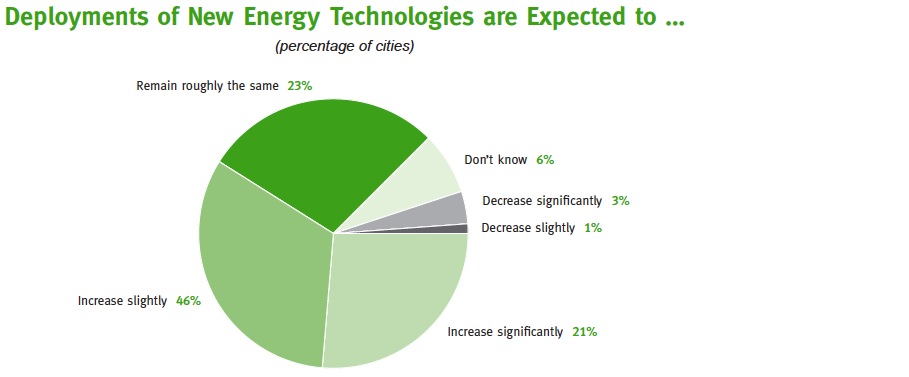THE UNITED STATES CONFERENCE OF MAYORS
Nearly three in ten cities are making LED/energy-efficient lighting technology their top priority over the next 24 months. Mayors choose LED/energy-efficient lighting (29%) as the energy technology receiving top priority in their cities within the next two years.
In addition to prioritizing LED/energy-efficient lighting technology, mayors rank solar technology systems as their second choice, with nearly one in five cities (19%) making this selection. The third and fourth priorities are building retrofits (18%) and unspecified renewable energy technologies (8%), respectively.
Cities were asked to describe their one “top priority” in their own words, rather than selecting from multiple choice answers, the format used for nearly all other questions in this survey. Ninety-one percent of all cities participating in the survey – 263 out of 288 cities – responded to this question, with the responses as shown above grouped by categories. The “All other” category captures several additional response categories, including cogeneration, waste-to-energy, and water treatment technologies.
Most mayors expect to use their own local resources, followed by partnerships with the private sector, as the sources of financing for their “top priority” technologies over the next 24 months. Mayors identify three city fund sources – city capital funds, city operating funds and city utility/enterprise funds – as the primary resources for advancing their priority technologies. Near majorities expect city operating budgets (46%) and capital improvement program funds (45%) to be the top two sources. One in four cities (26%) list utility/enterprise funds (e.g., solid waste, water or wastewater utility funds) as a source of funding for these deployments.
After city resources, private sector offerings are cited most often: private utility financing (14%), energy performance contracting (23%) and other public-private partnerships (26%). Slightly more than one in five cities identify state funding (22%) as a source of support for their priorities, and one in five cities expect federal funding (20%). Notably, these results and others throughout this report show dramatic shifts in expectations of the Federal government’s role in supporting cities with technology deployment as well as other energy initiatives.
Many mayors anticipate further growth in the deployment of new energy technologies in cities. Two-thirds (67%) of the 288 cities participating in this survey expect the use of new energy technologies to increase over the next five years, with more than one in five cities (21%) in this survey expecting the increase to be “significant.”
Nearly one in four mayors (23%) predicts commitments by cities to new energy technologies will remain about the same. Only four percent of the respondents expect these commitments to decline during this period.
Download full version (PDF): Energy Efficiency and Technologies in America’s Cities
About the United States Conference of Mayors
www.USMayors.org
“The U.S. Conference of Mayors (USCM) is the official nonpartisan organization of cities with populations of 30,000 or more. There are 1,204 such cities in the country today. Each city is represented in the Conference by its chief elected official, the mayor.”









 RSS Feed
RSS Feed